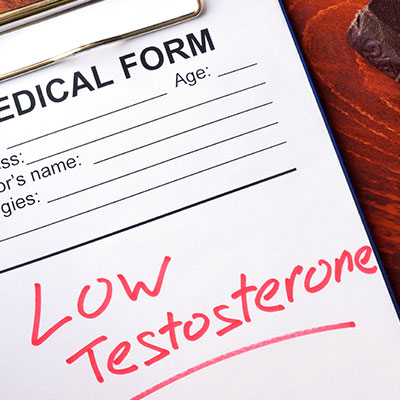Testosterone Therapy Before and After
Contents
- How Long Does It Take to See Results From Testosterone Therapy?
- Overview of the Many Benefits of Testosterone Therapy
- Testosterone Therapy Results for Men – Month by Month
- Testosterone Therapy Results for Women – Month by Month
- How Long Do the Results of Testosterone Therapy Last?
- What do the Studies Have to Say About Testosterone Results

Testosterone replacement therapy is prescribed for patients who have been diagnosed with low testosterone or a testosterone deficiency. Testosterone therapy is usually prescribed for a period of six months, after which both men and women receiving testosterone replacement should experience noticeable before and after results.
The many positive benefits of testosterone therapy are designed to be cumulative. Each month that you are on testosterone therapy, you can expect to see more and more before and after results.
How Long Does It Take to See Results From Testosterone Therapy?
When wondering about the before and after results of testosterone treatment, one thing that you must keep in mind is that while you will see potentially dramatic results, you will not suddenly look like you did 20 years ago after your first low testosterone treatment. The whole reason why testosterone therapy is given as a program of weekly injections over a few months is that its effects are designed to be cumulative and take time to be achieved.
Also, please keep in mind that since every case of low testosterone is different and each of our bodies reacts to hormones differently, how long it will take for you to see the first results of testosterone replacement will vary. Generally speaking, you will start to notice some changes within the first two to four weeks of testosterone therapy.
A Trusted sourceOnset of effects of testosterone treatment and time span until maximum effects are achievedNCBIGo to source2011 study on when to expect to see results from testosterone therapy found, “Effects on sexual interest appear after three weeks plateauing at six weeks, with no further increments expected beyond. Changes in erections/ejaculations may require up to 6 months. Effects on quality of life manifest within 3–4 weeks, but maximum benefits take longer. Effects on depressive mood become detectable after 3–6 weeks with a maximum after 18–30 weeks.”
Overview of the Many Benefits of Testosterone Therapy
The before and after results that anyone can expect – men or women – on testosterone therapy will impact four major areas of your life:
- Physical strength
- Sexual performance
- Mental acuity
- Emotional wellbeing
Testosterone Therapy Results for Men – Month by Month
Each month you are on testosterone, you will see increasing benefits impacting one or more of the areas of your life. Here is a month-by-month breakdown of the kind of results you can expect each month you are on testosterone.
Testosterone Therapy Results After One Month
During your initial four to six weeks of testosterone therapy, the first you will notice is significant increases in vitality and energy. You should also start to see:
- Improved mood
- Improved ability to focus and concentrate
- A reduction of belly fat
- Increased muscle mass
Testosterone Therapy Results After Two Months

- Improved sleep
- Continued improvements in libido or sex drive, increased number of spontaneous erections
- A reduction in cholesterol levels
- Increased stamina
- A reduction in systemic inflammation
Testosterone Therapy Results After Three Months
As you complete your third month of testosterone therapy, your benefits will continue to accumulate. In month three, you should see:
- Reduced anxiety and agitation
- Decreased total cholesterol and triglycerides (LDL levels may take a little longer)
- Increased HDL (good) cholesterol may begin at this point
- Improvements in glycemic control
- Increased red blood cell production
- Possible decline in diastolic blood pressure (maximum effects noted at 12-month mark)
Testosterone Therapy Results After Four Months
As you finish your third and enter your fourth month of testosterone therapy, in addition to continued improvements in strength, vitality, and sexual performance, you can expect the following additional before and after benefits of testosterone:
- Healthier hair
- Improved bone health and bone density
- Decrease in diastolic blood pressure
- Reduction in arterial plaque
- Increased exercise capacity
Testosterone Therapy Results After Five Months
Although you are unlikely to see new benefits in month five, there will continue to be an overall strengthening of everything that has come before. You will barely be able to recognize the person you were before you started testosterone therapy.
Testosterone Therapy Results After Six Month
Once you are close to completing your first course of testosterone therapy in month 6, you will experience all of the many well-documented benefits of testosterone replacement therapy and an overall improved quality of life.
The complete list of positive results of testosterone therapy are as follows:
- Increased energy
- Improved mood
- Better memory and cognition
- Improved sex life
- Loss of fat, lower BMI, and increased lean muscle
- Reduced risk of cardiovascular disease
- A reduce your risk of osteoporosis
- An overall improvement of quality of life
Testosterone Therapy Results for Women – Month by Month

First Month Testosterone Therapy Results
Some specific results of testosterone women can expect to see in the first month of therapy include:
- Improved sex drive, sexual thoughts, fantasy, satisfaction, and libido
- Increase in vaginal lubrication
- Reduced anxiety and depression
- Improved skin and hair
Testosterone Therapy Results Second Month
In the second month of testosterone replacement, women can expect:
- Improved lipid profile – decrease in triglycerides and total cholesterol
- Continued increases in sexual performance, less vaginal dryness, reduction of painful intercourse
- Overall reduction of systemic inflammation
Third Month of Testosterone Therapy Replacement Results
By the third month, the testosterone therapy women should start to notice some significant before and after results, including:
- Improved mood
- Decreased depression symptoms
- Improved erythropoiesis – formation of red blood cells
- Increased exercise capacity
- Decrease in LDL cholesterol and increase in HDL cholesterol
Fourth Month Testosterone Therapy Results
Significant body changing results begin to kick in for women who have been on testosterone for four months. In addition to all the benefits listed so far, in month four, women will see:
- Noticeable change in lean body mass, fat mass, and muscle strength
- Increased bone density
- Reduction of PMS symptoms (pre-menopausal women)
- Reduction of menopausal symptoms (menopausal and post-menopausal women)
Fifth Month Testosterone Therapy Results
In month five, as you are approaching the end of your six-month regimen of testosterone replacement, you will probably be fitter, stronger, and in better shape than you have ever been in your life. If you were prescribed testosterone for menopause by month five, you will see a reduction or elimination of all of the worst of your menopause symptoms.
Sixth Month Testosterone Therapy Results
After six months of treatment, most women will have completed their testosterone replacement treatment plan, and most likely, you will be hardly recognizable as the same woman who took that first injection six months ago. You can now look proudly in the mirror and see all of many positive before and after benefits of testosterone replacement therapy listed above and an overall improved quality of life.
How Long Do the Results of Testosterone Therapy Last?
Testosterone therapy is an ongoing treatment that continues long-term. After your first six months of treatment, your hormone levels and symptoms will be reevaluated to see if you need to continue treatment.
Most patients continue for at least another six months and spend a full year on treatment. After that, you will likely be evaluated every three months to see if you need to return to testosterone treatment. Once you complete your program, you will be given diet and lifestyle changes that will help to keep your testosterone levels high and help you to maintain the before, and after results you obtained.
What do the Studies Have to Say About Testosterone Results
Over the last few decades, testosterone replacement therapy has been studied extensively. There have been many studies in respected clinical journals that prove the before, and after results you can expect with testosterone therapy.
A Trusted sourceResults of long term testosterone replacement therapy in men with abdominal obesity, erectile dysfunction and testosterone deficiencyPubMedGo to source2018 study concluded, “testosterone replacement therapy had multiple positive effects on affected men with [low testosterone]. Our long-term results showed a long-lasting improvement during the time [the subjects were on testosterone]. Authors concluded that long-term treatment had multiple benefits for affected the men.”
A Trusted sourceLong-term testosterone treatment in elderly men with hypogonadism and erectile dysfunction reduces obesity parameters and improves metabolic syndrome and health-related quality of lifePubMedGo to sourcestudy in 2014 on obese men with low testosterone and erectile dysfunction concluded, “Long-term testosterone replacement in men with low testosterone and ED reduces obesity parameters and improves metabolic syndrome and health-related quality of life.”
The results of an Trusted sourceEffects of 8-Year Treatment of Long-Acting Testosterone Undecanoate on Metabolic Parameters, Urinary Symptoms, Bone Mineral Density, and Sexual Function in Men With Late-Onset HypogonadismPubMedGo to sourceeight-year study that was published in 2016 found that “Long-term testosterone treatment in men with low testosterone up to 8 years appears to be safe, tolerable, and effective in correcting obesity parameters, urinary symptoms, bone mineral density, and sexual function in men with late-onset hypogonadism.”
This is just a small sample of the countless clinical trials that have proven the many positive before and after results of testosterone replacement therapy.
Recently, researchers from the prestigious Perelman School of Medicine at the University of Pennsylvania, in association with a dozen other well-respected medical centers nationwide, conducted seven clinical trials in partnership with the National Institute on Aging to determine the value of testosterone replacement therapy for aging men. A recent landmark collective study known as the Trusted sourceResearchers Find Testosterone Treatment Improves Sexual Activity, Walking Ability and Mood in Men Over 65Penn MedicineGo to source“Testosterone Trials” (TTrials) concluded that “The trials showed an improvement in all the aspects of sexual function and overall mood.”
The TTrials were a coordinated set of seven placebo-controlled, double-blind trials in 788 men with a mean age of 72 years, designed to determine the efficacy of increasing the testosterone levels of older men with low testosterone through the use of testosterone replacement therapies.
The findings of the Testosterone Trials were published in March of 2018. The key takeaways from the TTrials were that for older men with low testosterone, testosterone treatment for one year:
- Improved all aspects of sexual function
- Improved strength and mobility
- Improved mood and depressive symptoms
- Markedly increased bone mineral density and estimated bone strength.
Now that you know a lot more about the before and after results of testosterone injections, why not take a minute to contact us and learn more about the many other life-changing benefits of testosterone therapy.
FAQ
1. What is testosterone therapy?
Testosterone therapy is used to treat men and women who have been diagnosed with low testosterone. Testosterone therapy is designed to make you feel younger, stronger, and improve your confidence, so you can continue to do all the things you enjoy most in life.
2. What causes low testosterone?
Any disease or condition that impairs your body's ability to produce testosterone can lead to hypogonadism or low testosterone. Some cancers can do this, as can other conditions or injury to the testes. However, the most common cause of low testosterone is the natural decline in testosterone that occurs as men age. Testosterone production continues through adolescence until it reaches its highest level at about the age of eighteen.
In most men, their testosterone levels will stay at or pretty close to that maximum level through their 20s. Then, once you are over 30, your testosterone level will start on a steady downward slope. By the time you are over 40, most men will be feeling the negative impacts of low testosterone.
3. What are the symptoms of low testosterone?
The signs and symptoms of low testosterone, also known as Low-T include:
- A decrease in libido or sex drive
- An overall feeling of reduced virility and vigor
- Changes in mood
- Erectile dysfunction
- Loss of stamina
- Loss of muscle tone
- Weight gain
- Loss of memory and other cognitive issues
4. How is low testosterone diagnosed?
Usually, a simple blood test that measures your testosterone level is all that is needed to receive a diagnosis of low testosterone. There are some testosterone clinics that rely on a swab saliva test to determine testosterone levels, but the only real accurate measure and way to give a precise diagnosis of low testosterone is with a blood test.
5. How low does your testosterone level need to be to require treatment?
While there are clinical guidelines that define low testosterone, it is hard to say how low your testosterone has to be to require treatment. This is because testosterone levels are very individual. What is normal for you could be fine for someone else. All men will lose testosterone as they age.
Some men will barely notice the loss. For others, the deficiency can be devastating. So, rather than speaking of normal levels, it is better to think in terms of symptoms. If you are exhibiting the signs of low T, your levels are probably low enough to need treatment.




